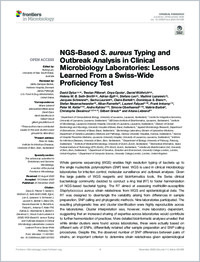NGS-based S. aureus typing and outbreak analysis in clinical microbiology laboratories : Lessons learned from a Swiss-wide proficiency test
- Dylus, David Department of Computational Biology, University of Lausanne, Lausanne, Switzerland - Center for Integrative Genomics, University of Lausanne, Lausanne, Switzerland - SIB Swiss Institute of Bioinformatics, Lausanne, Switzerland
- Pillonel, Trestan Institute of Microbiology, Lausanne University Hospital, University of Lausanne, Lausanne, Switzerland
- Opota, Onya Institute of Microbiology, Lausanne University Hospital, University of Lausanne, Lausanne, Switzerland
- Wüthrich, Daniel Division of Clinical Bacteriology and Mycology, University Hospital of Basel, Basel, Switzerland - Applied Microbiology Research, Department of Biomedicine, University of Basel, Basel, Switzerland
- Seth-Smith, Helena M. B. Division of Clinical Bacteriology and Mycology, University Hospital of Basel, Basel, Switzerland - Applied Microbiology Research, Department of Biomedicine, University of Basel, Basel, Switzerland
- Egli, Adrian Division of Clinical Bacteriology and Mycology, University Hospital of Basel, Basel, Switzerland - Applied Microbiology Research, Department of Biomedicine, University of Basel, Basel, Switzerland
- Leo, Stefano Bacteriology Laboratory, Division of Laboratory Medicine, Department of Genetics Laboratory Medicine and Pathology, Geneva University Hospitals, Geneva, Switzerland
- Lazarevic, Vladimir Bacteriology Laboratory, Division of Laboratory Medicine, Department of Genetics Laboratory Medicine and Pathology, Geneva University Hospitals, Geneva, Switzerland
- Schrenzel, Jacques Bacteriology Laboratory, Division of Laboratory Medicine, Department of Genetics Laboratory Medicine and Pathology, Geneva University Hospitals, Geneva, Switzerland
- Laurent, Sacha Institute of Microbiology, Lausanne University Hospital, University of Lausanne, Lausanne, Switzerland
- Bertelli, Claire Institute of Microbiology, Lausanne University Hospital, University of Lausanne, Lausanne, Switzerland
- Blanc, Dominique S. Service of Hospital Preventive Medicine, Lausanne University Hospital, University of Lausanne, Lausanne, Switzerland
- Neuenschwander, Stefan Institute for Infectious Diseases, University of Bern, Bern, Switzerland
- Ramette, Alban Institute for Infectious Diseases, University of Bern, Bern, Switzerland
- Falquet, Laurent SIB Swiss Institute of Bioinformatics, Lausanne, Switzerland - Department of Biology, University of Fribourg, Fribourg, Switzerland
- Imkamp, Frank Institute of Medical Microbiology, University of Zurich, Zurich, Switzerland
- Keller, Peter M. Institute of Medical Microbiology, University of Zurich, Zurich, Switzerland
- Kahles, Andre SIB Swiss Institute of Bioinformatics, Lausanne, Switzerland - Biomedical Informatics, Swiss Federal Institute of Technology (ETH Zürich), ETH Zürich, Zurich, Switzerland
- Oberhaensli, Simone SIB Swiss Institute of Bioinformatics, Lausanne, Switzerland - Interfaculty Bioinformatics Unit, University of Bern, Bern, Switzerland
- Barbié, Valérie SIB Swiss Institute of Bioinformatics, Lausanne, Switzerland
- Dessimoz, Christophe Department of Computational Biology, University of Lausanne, Lausanne, Switzerland - Center for Integrative Genomics, University of Lausanne, Lausanne, Switzerland - SIB Swiss Institute of Bioinformatics, Lausanne, Switzerland - Department of Genetics, Evolution and Environment, University College London, London, United Kingdom - Department of Computer Science, University College London, London, United Kingdom
- Greub, Gilbert Institute of Microbiology, Lausanne University Hospital, University of Lausanne, Lausanne, Switzerland
- Lebrand, Aitana SIB Swiss Institute of Bioinformatics, Lausanne, Switzerland
- 24.11.2020
Published in:
- Frontiers in Microbiology. - 2020, vol. 11, p. 591093
English
Whole genome sequencing (WGS) enables high resolution typing of bacteria up to the single nucleotide polymorphism (SNP) level. WGS is used in clinical microbiology laboratories for infection control, molecular surveillance and outbreak analyses. Given the large palette of WGS reagents and bioinformatics tools, the Swiss clinical bacteriology community decided to conduct a ring trial (RT) to foster harmonization of NGS-based bacterial typing. The RT aimed at assessing methicillin-susceptible Staphylococcus aureus strain relatedness from WGS and epidemiological data. The RT was designed to disentangle the variability arising from differences in sample preparation, SNP calling and phylogenetic methods. Nine laboratories participated. The resulting phylogenetic tree and cluster identification were highly reproducible across the laboratories. Cluster interpretation was, however, more laboratory dependent, suggesting that an increased sharing of expertise across laboratories would contribute to further harmonization of practices. More detailed bioinformatic analyses unveiled that while similar clusters were found across laboratories, these were actually based on different sets of SNPs, differentially retained after sample preparation and SNP calling procedures. Despite this, the observed number of SNP differences between pairs of strains, an important criterion to determine strain relatedness given epidemiological information, was similar across pipelines for closely related strains when restricting SNP calls to a common core genome defined by S. aureus cgMLST schema. The lessons learned from this pilot study will serve the implementation of larger-scale RT, as a mean to have regular external quality assessments for laboratories performing WGS analyses in a clinical setting.
- Faculty
- Faculté des sciences et de médecine
- Department
- Département de Biologie
- Language
-
- English
- Classification
- Biological sciences
- License
-
License undefined
- Identifiers
-
- RERO DOC 329863
- DOI 10.3389/fmicb.2020.591093
- Persistent URL
- https://folia.unifr.ch/unifr/documents/308954
Other files
Statistics
Document views: 208
File downloads:
- pdf: 279
- Supplementary material: 150

